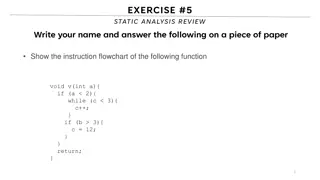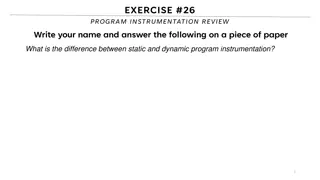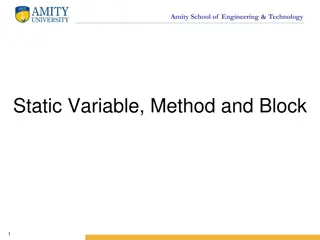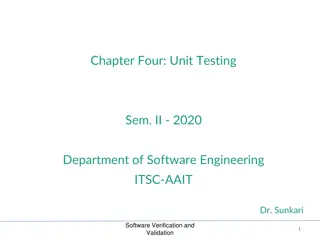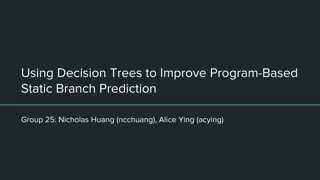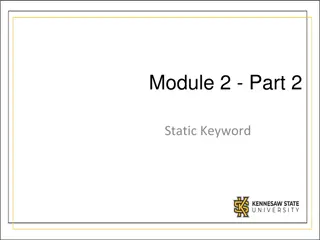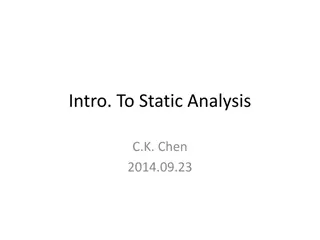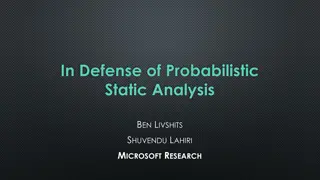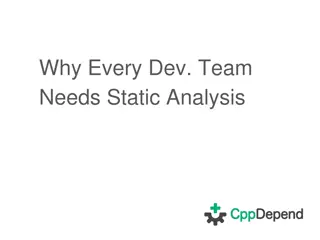
Effective Bug Reduction Approaches and Testing Strategies
Learn about static analysis techniques, bug reduction approaches, testing concepts, and granularity of testing in software development. Understand the importance of code coverage and how to write effective test cases to ensure software quality and reliability.
Download Presentation

Please find below an Image/Link to download the presentation.
The content on the website is provided AS IS for your information and personal use only. It may not be sold, licensed, or shared on other websites without obtaining consent from the author. If you encounter any issues during the download, it is possible that the publisher has removed the file from their server.
You are allowed to download the files provided on this website for personal or commercial use, subject to the condition that they are used lawfully. All files are the property of their respective owners.
The content on the website is provided AS IS for your information and personal use only. It may not be sold, licensed, or shared on other websites without obtaining consent from the author.
E N D
Presentation Transcript
Static analysis Hao Zhong Shanghai Jiao Tong University
Last class Quality engineer Faults and their detection approaches
Approach to reduce bugs Testing Feed input to software and run it to see whether its behavior is as expected Limitations Impossible to cover all cases Static checking Identify specific problems (e.g., memory leak) in the software by scanning the code or all possible paths Limitations False positives
Approach to reduce bugs Formal Proof Formally prove that the program implements the specification Limitations The proof does not guarantee the correctness of implementation Inspection Manually review the code to detect faults Limitations: Huge manual effort
Testing: Concepts Test case An execution of the software with a given list of input values Include: Input values, sometimes fed in different steps Output values Test oracle The expected outputs of software by feeding in a list of input values A part of test cases A hard problem in auto-testing: test oracle problem
Granularity of testing Unit Testing Test of a single module Integration Testing Test the interaction between modules System Testing Test the system as a whole, by developers on test cases
Writing a Test Case public class VectorTest extends TestCase { // extending Junit TestCase protected Vector vf; protected void setUp() { // executed before every test vf = new Vector(); // Generate SUTs } @Test // annotation: tell Junit a test method public void test1() { // a test method assertTrue(vf.size() == 100+size); //assertion, compare output with expected } @Test // annotation: tell Junit a test method public void test2() { // a test method } void tearDown{ vf.clear(); } }
Test measures Code Coverage Definition: Divide the code to elements Calculate the proportion of elements that are executed by the test suite Criteria Statement coverage Branch coverage Data flow coverage Mutation test program test suite mutated programs Requirement coverage requirement test suite
Software process models Requirements engineering Programmer Quality engineer Design Implementation Integration The waterfall model
Approach to reduce bugs Testing Feed input to software and run it to see whether its behavior is as expected Limitations Impossible to cover all cases Static checking Identify specific problems (e.g., memory leak) in the software by scanning the code or all possible paths Limitations False positives
Testing bugs code executable file compile test case oracle
Static bug detection AST bugs code graph check parse model oracle
Static bug detection Static bug detection is a less popular approach for software quality assurance, compared with testing Compared to testing Sometimes not scalable Generate false positives Easy to start ( no setup, no install ) Sometimes can guarantee the software to be free of certain kinds of bugs No need for debugging Some tools do not need compiled code
State-of-practice: static bug detection Findbugs A tool developed by researchers from UMD Widely used in industry for code checking The idea actually comes from Lint Lint A code style enforcing tool for C language Find bad coding styles and raise warnings Bad naming Hard coded strings
Characters of Findbugs More than 400 rules Bug patterns include both legal and illegal usages Most are illegal ones Why? Check code patterns locally: only do inner-procedure analysis What are the advantages and disadvantages of doing so? Perform bug ranking according to the probability and potential severity of bugs Probability: the bug is likely to be true Severity: the bug may cause severe consequence if not fixed
Application of Findbugs-like tools Findbugs is adopted by a number of large companies such as Google A statistics in Google 2009: More than 4000 issues are identified, in which 1700 bugs are confirmed, and 1100 are fixed. Another tool is PMD, an alternative of Findbugs Usually only the issues with highest confidence/severity are reported as issues Sunghun Kim and Michael D Ernst. 2007. Which warnings should I fix first?. In Proc. ESEC/FSE. 45 54. In this paper, we propose a history-based warning prioritization algorithm by mining warning fix experience that is recorded in the software change history. The underlying intuition is that if warnings from a category are eliminated by fix-changes, the warnings are important. Our prioritization algorithm improves warning precision to 17%, 25%, and 67% respectively
Defined oracles in Findbugs Bad practice DMI: Don't use removeAll to clear a collection If you want to remove all elements from a collection c, use c.clear, not c.removeAll(c). Calling c.removeAll(c) to clear a collection is less clear, susceptible to errors from typos, less efficient and for some collections, might throw a ConcurrentModificationException. Correctness NP: Null pointer dereference A null pointer is dereferenced here. This will lead to a NullPointerException when the code is executed. Malicious code vulnerability MS: Field isn't final and can't be protected from malicious code A mutable static field could be changed by malicious code or by accident from another package.
Defined oracles in Findbugs Performance Dm: Method invokes inefficient Boolean constructor Creating new instances of java.lang.Boolean wastes memory, since Boolean objects are immutable and there are only two useful values of this type. Use the Boolean.valueOf() method (or Java 1.5 autoboxing) to create Boolean objects instead. Multithreaded correctness SWL: Method calls Thread.sleep() with a lock held This method calls Thread.sleep() with a lock held. This may result in very poor performance and scalability, or a deadlock, since other threads may be waiting to acquire the lock. It is a much better idea to call wait() on the lock, which releases the lock and allows other threads to run.
Defined oracles in Findbugs Security Dm: Hardcoded constant database password This code creates a database connect using a hardcoded, constant password. Anyone with access to either the source code or the compiled code can easily learn the password.
Bad practice vs correctness Method names H st, Einar W., and Bjarte M. stvold. Debugging method names. In European Conference on Object-Oriented Programming, pp. 294-317. Springer, Berlin, Heidelberg, 2009. Parameter and argument names Hui Liu, Qiurong Liu, Cristian-Alexandru Staicu, Michael Pradel, Yue Luo. Nomen est Omen: Exploring and Exploiting Similarities between Argument and Parameter Names. The 38th International Conference on Software Engineering (ICSE 2016), 1063-1073
Testing bugs code executable file compile test case oracle
Static bug detection AST bugs code graph check parse model oracle
General oracles Divide by 0 a/b b!=0 Null Pointer Reference a.field a!=null Buffer Overflow a[x] x<a.length() p.malloc() p.free() Memory Leak deadlock Infinite Loop lock(s) unlock(s) while(Condition) F(!Condition)
More Oracles? Tools such as Findbugs already defined hundreds of rules. Why insufficient? API library J2SE alone defines thousands of classes Static tools handle APIs as black boxes Project-specific rules Outsiders rarely know Static tools do not define project-specific rules It is challenging to define such rules manually
Oracle Types Value Oracle The value (s) of one or several variable (s) must satisfy a certain constraint Final Exam Score <= 100 sortedlist(0) >= sortedlist(1) http_url.startsWith( http ) Temporal oracle Two events (or a series of events) must (not) happen in a certain order Specification lock() unlock() file.open() file.close() and file.open() file.read() Bug signature file.close() file.read() What is the difference?
Oracle Types Data flow specification Data from a certain source must / must not flow to a certain sink Android applications ! Contact Info Internet Password encryption Internet Data Flow Specification are mainly for security usage
Inference Static symbolic execution y = read(); y = 2 * y; if (y <= 12) y = 3; else y = y + 1; print ("OK"); T (y=s), s is a symbolic variable for input T (y=2*s) T2*s<=12 (y = 3) T!(2*s<=12) (y= 2*s + 1) T 2*s<=12 (y= 3 ) | T!(2*s<=12) (y=2*s + 1) T s<=6 (y= 3 ) | Ts>6 (y=2*s + 1) API?
Mining specifications Learning from correct usages Inputs Client code Traces Techniques: Frequent sequential mining Frequent subgraph mining Grammar inference Output Automata Frequent call sequences Graphs
Mining Original program Instrumented program Data trace database Invariants Detect invariants Instrument Run Test suite Dynamically discovering likely program invariants to support program evolution by Michael D. Ernst, Jake Cockrell, William G. Griswold, and David Notkin. IEEE Transactions on Software Engineering, vol. 27, no. 2, Feb. 2001, pp. 99-123.
Mining specifications Learning from documents Inputs API doc Inferring resource specifications from natural language API documentation Hao Zhong, Lu Zhang, Tao Xie, and Hong Mei In Proc. International Conference on Automated Software Engineering (ASE), pages 307-318, 2009. Techniques: NLP Outputs:
Mining bug signature Learning from bugs and bug fixes Techniques Frequency-based mining Mining subgraph Discriminative graph mining Hao Zhong, Xiaoyin Wang, and Hong Mei. Inferring bug signatures to detect real bugs. IEEE Transaction on Software Engineering, pages to appear, 2020. Outputs:
More oracles: documentation Zhong, Hao. and Su, Zhendong., 2013, Detecting API documentation errors. In Proc. OOPSLA, pp. 803-816). Natural language sentence with code names Out-of-date code reference Natural language sentence Code example
More oracles: differential testing An application has multiple implementations JVM: Sun J2SE, Open JDK, IBM J9, Compiler: gcc, llvm, SSH servers: Apache MINA SSHD, Dropbear, Linux: Ubuntu, Redhat, Database Refactoring One software has different implementations Same inputs Same outputs Differential testing for software McKeeman, William M. Digital Technical Journal 10.1 (1998): 100-107. Exposing behavioral differences in cross-language API mapping relations Hao Zhong, Suresh Thummalapenta, and Tao Xie In Proc. Fundamental Approaches to Software Engineering (ETAPS/FASE), pages 130-145, 2013.
More oracles: Metamorphic Testing Two or more values shall follow some constraints Fibonacci sequence Fi=Fi 1+Fi 2,F1=F2=1
What after you have oracles? It is still nontrivial to check whether a program follow or violate oracle. Static analysis is not fully correct. How to determine the value of a variable? How to determine the type of a variable? How to determine the attributes of an object? (Python)
Static bug detection AST bugs code graph check parse model oracle
Graph-based analysis Transform the program to graphs WALA, SOOT Compiler optimization Detecting violations of specifications traversing graphs Detecting instances of bug signatures identifying subgraphs
An example f is not closed Start Checking whether a file is closed in all cases boolean load(){ f.open(); line = f.read(); while(line!=null){ if(line.contains('key')){ f.close() return true; }else if(line.contains('value')){ f.close() } line = f.read(); } return false; } opened new line read !=null key value closed none ==null closed ret
Problems of Static tools Lack of oracles Very rare project-specific formal specification Solutions: General specifications (for typical bugs) Mining specifications (for API-specific, project-specific specifications) Mining bug signatures False Positives vs. Efficiency More sensitivities higher cost Path sensitivity is rarely achieved Combination of all sensitivities Incomputable problems
The challenges of bug analysis Johnson, Brittany, Yoonki Song, Emerson Murphy-Hill, and Robert Bowdidge. "Why don't software developers use static analysis tools to find bugs?." In Proc. ICSE, pp. 672-681. 2013. Some programmers hate false alarms Legunsen O, Hassan Wu, Xu X, Ro u G, Marinov D. How good are the specs? A study of the bug-finding effectiveness of existing Java API specifications. In Proc. ASE 2016 (pp. 602-613). 182 manually written specs and 17 automatically mined specs 200 open source projects JavaMOP (dynamic) We reported 95 bugs, out of which developers already fixed 74. Most violations, 82.81% of 652 and 97.89% of 200, were false alarms
This class Static bug detection Oracle Value Temporal Data flow Mining oracles Existing client code Existing buggy code Documents Code styles Declaration before usage
Testing bugs code executable file compile test case oracle
Static bug detection AST bugs code graph check parse model oracle
General oracles Divide by 0 a/b b!=0 Null Pointer Reference a.field a!=null Buffer Overflow a[x] x<a.length() p.malloc() p.free() Memory Leak deadlock Infinite Loop lock(s) unlock(s) while(Condition) F(!Condition)
Oracle Types Value Oracle The value (s) of one or several variable (s) must satisfy a certain constraint Final Exam Score <= 100 sortedlist(0) >= sortedlist(1) http_url.startsWith( http ) Temporal oracle Two events (or a series of events) must (not) happen in a certain order Specification lock() unlock() file.open() file.close() and file.open() file.read() Bug signature file.close() file.read() What is the difference?
Oracle Types Data flow specification Data from a certain source must / must not flow to a certain sink Android applications ! Contact Info Internet Password encryption Internet Data Flow Specification are mainly for security usage
More oracles: differential testing An application has multiple implementations JVM: Sun J2SE, Open JDK, IBM J9, Compiler: gcc, llvm, SSH servers: Apache MINA SSHD, Dropbear, Linux: Ubuntu, Redhat, Database Refactoring One software has different implementations Same inputs Same outputs Differential testing for software McKeeman, William M. Digital Technical Journal 10.1 (1998): 100-107. Exposing behavioral differences in cross-language API mapping relations Hao Zhong, Suresh Thummalapenta, and Tao Xie In Proc. Fundamental Approaches to Software Engineering (ETAPS/FASE), pages 130-145, 2013.
More oracles: Metamorphic Testing Two or more values shall follow some constraints Fibonacci sequence Fi=Fi 1+Fi 2,F1=F2=1
Next class Debugging


